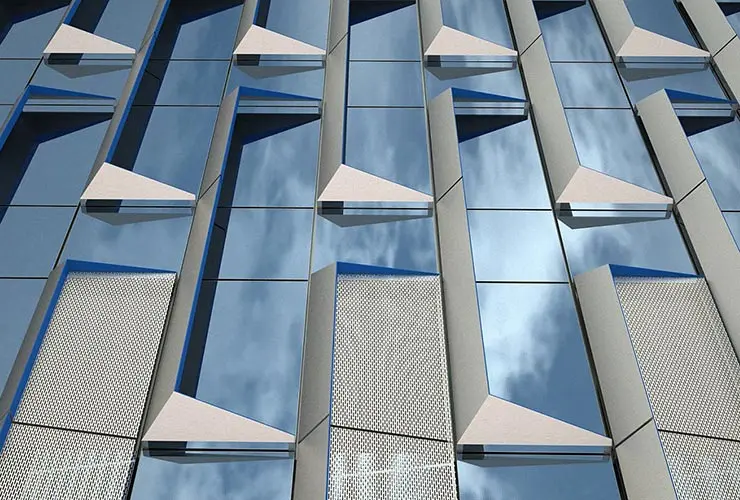Adaptive Facade systems that evolve with the environment
Adaptive facade design has moved beyond static structures. Today, facades play an active role in energy efficiency. Through remote, precision-driven development, we create facades that adjust based on real-time weather data and time of day, maximizing energy savings while elevating building aesthetics.
Get in touch
What Makes an Adaptive Facade Unique?
Unlike traditional facades, adaptive systems dynamically change their properties to respond to environmental conditions. Whether it's temperature, sunlight, or wind, these facades adapt in real-time, contributing to reduced energy consumption and improved indoor comfort. This is more than a facade—it’s a responsive, living system integrated into your building.


How Adaptive Facades Improve Energy Efficiency
Every adaptive facade is a customized response to its specific environment. By harnessing solar energy, controlling heat transfer, and optimizing natural light, these facades reduce the demand for artificial lighting and HVAC systems. An optimized facade design can result in up to 30% reduction in energy costs, contributing directly to a building's sustainability goals.
Contact usWhy Choose Termwus
Termwus offer more than just visual appeal—they’re designed to enhance energy efficiency, improve occupant comfort, and support sustainable building practices. Here are the top reasons why adaptive facades are transforming modern architecture:
Get in touchEnergy Efficiency
Adaptive facades minimize energy usage by adjusting to real-time environmental changes, reducing the need for heating, cooling, and artificial lighting.
Improved Comfort
These systems create an ideal indoor climate by controlling light and temperature, enhancing comfort throughout the year
Sustainable Design
By integrating eco-friendly materials and reducing energy demands, adaptive facades contribute to a building’s sustainability goals.
Aesthetic Flexibility
Customizable materials and designs allow adaptive facades to make a striking architectural statement that suits any environment.
Ready-to-Install Adaptive Facade Solutions
These adaptive facade products are engineered for immediate installation, providing innovative solutions that enhance energy efficiency, environmental sustainability, and occupant comfort. Each product leverages intelligent design to respond dynamically to environmental factors—like sunlight, wind, and temperature—allowing buildings to optimize performance in real-time. Whether you’re looking to regulate light, control airflow, or stabilize interior temperatures, these products offer tangible, energy-saving benefits right out of the box.
Optimize your adaptive facade’s performance with this seasonal guide. Designed to help you adjust facade settings and maximize energy efficiency throughout the year, this digital guide provides actionable steps, environmental data analysis, and customization tips for different climate zones. Ensure your facade responds to seasonal changes, reducing energy costs and improving comfort.
Gain full control over your adaptive facade with our customizable control system template. This digital product provides a framework for monitoring and adjusting facade elements in real time, based on environmental data. The template includes automation scripts, sensor setup guidelines, and control panel designs to simplify the integration of your adaptive systems.
Streamline your adaptive facade installation with comprehensive installation plan blueprints. Each blueprint is customized for different panel types and environmental conditions, providing step-by-step instructions and remote installation guidance. This product includes diagrams, material lists, and technical specifications that ensure a precise and efficient installation.
Get access to a curated collection of adaptive facade panel designs tailored to various climates and building types. These templates include detailed 3D models, material specifications, and design variations that you can customize to fit your project. Perfect for architects and designers seeking a head start on sustainable facade solutions.
OurApproach
In developing adaptive facades, we utilize a tailored approach that combines environmental data analysis, material science, and cutting-edge technology. Our remote development model provides detailed insights at each phase—from concept to implementation—allowing clients to visualize and interact with their design before construction begins.
Get in touch
Frequently Asked Questions
An adaptive facade is a building exterior designed to respond dynamically to environmental changes, such as sunlight, temperature, and wind. By integrating smart materials and technologies, these facades can adjust their properties—like opacity, insulation, or airflow control—in real time. This helps optimize energy use, improve indoor comfort, and reduce the building's environmental impact.
Yes, adaptive facades can be implemented on various building types, including commercial, residential, and institutional structures. Depending on the specific requirements, adaptive elements can be customized to enhance energy efficiency, comfort, and sustainability, regardless of the building’s size or location.
The energy savings from an adaptive facade vary depending on the building’s location, climate, and the specific adaptive technologies used. On average, buildings with adaptive facades can reduce energy costs by up to 30%, thanks to decreased reliance on HVAC systems and artificial lighting.
Absolutely. Many adaptive facade systems, such as solar-responsive glass panels and wind-activated louvers, are designed to be compatible with existing structures. Retrofitting an existing building can significantly enhance its energy efficiency and bring it up to modern sustainability standards.
Adaptive facade materials are chosen for their durability and long lifespan. For instance, aluminum louvers are corrosion-resistant, and phase-change materials used in temperature-regulating panels are tested for resilience under various environmental conditions. These products are designed to withstand harsh weather and maintain optimal performance over time.
Adaptive facades generally require minimal maintenance. Most systems, like motorized shades and solar-responsive panels, are designed with low-maintenance materials. However, periodic inspections to ensure optimal functionality are recommended, especially for automated and dynamic components.
Have a question?
Let’s find the answers together—explore common questions or reach out for personalized insights.
